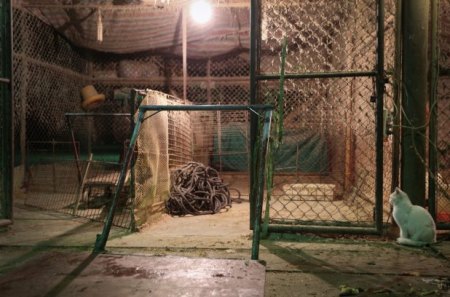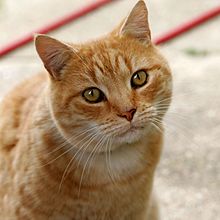A picture is worth a thousand words. Or nine lives. Or something like that.
The photo accompanaying today's Helen Branswell MetroNews/Canadian Press story regarding H7N9 avian influenza stuck out to me like a sore thumb.
Here's the photo. Can you tell what set me off?

If you said the cat, you'd be correct. Cats have a history with bird flu. In Indonesia, cats became such a worrisome vector that the government actually ordered the testing of cats. For the story, read my blog from 2007.
Also, in 2009, pH1N1 (the virus formerly known as swine flu) infected a housecat. Not in China; in Iowa. You can read my blog on that here. and the original Reuters story here. Wikipedia says:
Felidae (cats)
"In Bangkok, Thailand, all the cats in one household are known to have died of H5N1 in 2004. Tigers and leopards in Thai zoos also died, while in 2007 two cats near an outbreak in poultry and people in Iraq were confirmed to have died of H5N1, as were three German cats that ate wild birds. In Austria cats were infected but remained healthy". Cats in Indonesia were also found to have been infected with H5N1.[39]
The spread to more and more types and populations of birds and the ability of felidae (cats) to catch H5N1 from eating this natural prey means the creation of a reservoir for H5N1 in cats where the virus can adapt to mammals is one of the many possible pathways to a pandemic.
[edit] October 2004
Variants have been found in a number of domestic cats, leopards and tigers in Thailand, with high lethality.[40] "The Thailand Zoo tiger outbreak killed more than 140 tigers, causing health officials to make the decision to cull all the sick tigers in an effort to stop the zoo from becoming a reservoir for H5N1 influenza.[41][42] A study of domestic cats showed H5N1 virus infection by ingestion of infected poultry and also by contact with other infected cats (Kuiken et al., 2004)."[43] The initial OIE report reads: "the clinical manifestations began on 11 October 2004 with weakness, lethargy, respiratory distress and high fever (about 41-42 degrees Celsius). There was no response to any antibiotic treatment. Death occurred within three days following the onset of clinical signs with severe pulmonary lesions."[44]
[edit] February 28, 2006
A dead cat infected with the H5N1 bird flu virus was found in Germany.[45]
[edit] March 6, 2006
Hans Seitinger, the top agriculture official in the southern state of Styria, Austria announced that several still living cats in Styria have tested positive for H5N1:[46]
[edit] August 2006
It was announced in the August 2006 CDC EID journal that while literature describing HPAI H5N1 infection in cats had been limited to a subset of clade I viruses; a Qinghai-like virus (they are genetically distinct from other clade II viruses) killed up to five cats and 51 chickens from February 3 to February 5, 2006 in Grd Jotyar (~10 km north of Erbil City, Iraq). Two of the cats were available for examination.
- "An influenza A H5 virus was present in multiple organs in all species from the outbreak site in Grd Jotyar (Table). cDNA for sequencing was amplified directly from RNA extracts from pathologic materials without virus isolation. On the basis of sequence analysis of the full HA1 gene and 219 amino acids of the HA2 gene, the viruses from the goose and 1 cat from Grd Jotyar and from the person who died from Sarcapcarn (sequence derived from PCR amplification from first-passage egg material) are >99% identical at the nucleotide and amino acid levels (GenBank nos. DQ435200–02). Thus, no indication of virus adaptation to cats was found. The viruses from Iraq are most closely related to currently circulating Qinghai-like viruses, but when compared with A/bar-headed goose/Qinghai/65/2005 (H5N1) (GenBank no. DQ095622), they share only 97.4% identity at the nucleic acid level with 3 amino acid substitutions of unknown significance. On the other hand, the virus from the cat is only 93.4% identical to A/tiger/Thailand/CU-T4/2004(H5N1) (GenBank no. AY972539). These results are not surprising, given that these strains are representative of different clades (8,9). Sequencing of 1,349 bp of the N gene from cat 1 and the goose (to be submitted to GenBank) show identity at the amino acid level, and that the N genes of viruses infecting the cat and goose are >99% identical to that of A/bar-headed goose/Qinghai/65/2005(H5N1). These findings support the notion that cats may be broadly susceptible to circulating H5N1 viruses and thus may play a role in reassortment, antigenic drift, and transmission."[47]
[edit] January 24, 2007
"Chairul Anwar Nidom of Airlangga University in Surabaya, Indonesia, told journalists last week that he had taken blood samples from 500 stray cats near poultry markets in four areas of Java, including the capital, Jakarta, and one area in Sumatra, all of which have recently had outbreaks of H5N1 in poultry and people. Of these cats, 20% carried antibodies to H5N1. This does not mean that they were still carrying the virus, only that they had been infected - probably through eating birds that had H5N1. Many other cats that were infected are likely to have died from the resulting illness, so many more than 20% of the original cat populations may have acquired H5N1."[39]
Seeing a cat sitting outside an empty stall remined me immediately of these issues. Are the Chinese testing the cats? Are we seeing the death of cats in any significant number? Are the Chinese doing surveillance with veterinarians?
Cats eating wild birds is one thing. Cats eating diseased fowl in wet markets is another. Where are we more likely to see this?


Reader Comments (2)
The Shanghai H7N9 Wet Market Surveillance rNr Analytics show an unusual connection between one pigeon and the H5N1 infected tigers.
The full-text GeneWurx report has been made available as Open Access on the FluTrackers thread titled "China - H7N9 Human Isolates on Deposit at GISAID" at Post #30.
Scott, I could not help but think of this recent post of mine regarding a March 6, 2013 post I made out of Vietnam and cats...
TP - 6-3, patrol and traffic control-center Corporation (Rail Road Police Department - Police in Quang Ninh province) discovered and arrested two consecutive transfers large number of chicks and cats smuggled from the border inland.
Thai Binh heading control Mong Cai- Halong force detection function on the vehicle carrying 1.1 tons of cat no papers, no invoice enclosed."
http://pandemicinformationnews.blogspot.com/2013/03/vietnam-confiscated-cats-poultry.html
Commonground